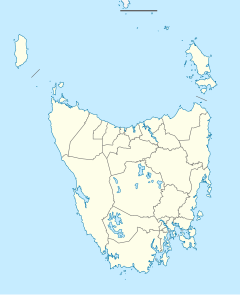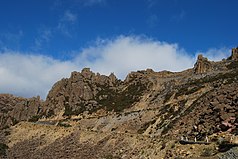Ben Lomond National Park
| Ben Lomond National Park | ||
|---|---|---|
| Rock formation at Ben Lomond | ||
|
|
||
| Location: | Tasmania , Australia | |
| Specialty: | Mountain landscape | |
| Next city: | Avoca, Fingal, Launceston | |
| Surface: | 165 km² | |
| Length: | 14th | |
| Founding: | 1947 | |
| Address: | Ben Lomond National Park | |
| Driveway to Ben Lomond | ||
The Ben Lomond National Park (English: Ben Lomond National Park ) is located in the northeast of the Australian state of Tasmania , about 50 km east of Launceston . The national park is about 165 km² and was founded on July 13, 1947.
General
The national park is named after Ben Lomond, the second highest Tasmanian mountain after Mount Ossa, at 1,572 m . The highest peak of the mountain is actually called Legges Tor, but the name Ben Lomond is more common. The plateau that dominates the park is surrounded on all sides by steep slopes. Large parts of the area have no ground cover. Bog soils have only formed in parts of the area, especially west of the Rodway Valley.
history
The national park is located in the area of the Ben Lomond tribe of the Aborigines, which consists of three to four groups with around 150 to 200 members.
Ben Lomond was named after a Scottish mountain of the same name. Its plateau was first explored between 1805 and 1806. After its founding in 1929, the Tasmanian Alpine Club began building hiking trails. In 1950 the Tasmanian Parliament decided to develop the area as a ski resort.
Flora and fauna
The national park protects a representative section of Tasmania's mountain plant communities in a wide range from alpine heathland to dense forests. A total of 222 different plant species have been identified so far. Species such as tussock grass ( Poa gunnii ), the heather family Richea scoparia and Epacris serpyllifolia as well as Baeckea gunniana are particularly common. Cushion plants are widespread in the plateau area. One of these plant species, Chionohebe ciliolata , only occurs in a small area of the park. Another endemic species of the park is Oreomyrrhis sessiliflora . The pearlwort Colobanthus curtisiae found in the park is particularly endangered .
The national park also plays a special role as a habitat for animals. Red-necked Wallaby , Wombat , Filander and Eastern Gray Giant Kangaroo are regularly observed. The long-snouted rabbit kangaroo , the short-billed hedgehog and the platypus also occur.
The park's bird life has not yet been studied in detail. However, species such as the wedge-tailed eagle , black cockatoo , yellow-bellied parakeet , yellow- lobed honeyeater and the honey-eater species Lichenostomus flavicollis and Melithreptus validirostris have been detected.
The reptile and amphibian fauna are similarly unexplored. The endemic northern snow kink Niveoscincus greeni and the Australian southern frogs Crinia signifera and Crinia tasmaniensis are noteworthy, however .
tourism
The area forms the focus of alpine skiing in Tasmania.
See also
Web links
- Side of the & Wildlife Service Tasmania Parks (English)
- Ski conditions on Ben Lomond (English)
- Climbing Ben Lomond ( Memento from May 2, 2005 in the Internet Archive )
Individual evidence
- ↑ Explanations of the natural features of the area
- ^ History of the area
- ↑ The plants in the national park
- ↑ a b The fauna in the national park
- ↑ Information Wildlife Service Tasmania


